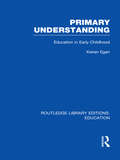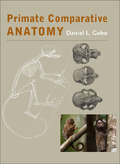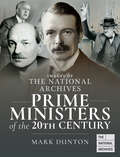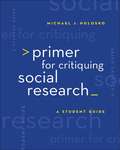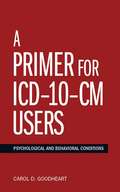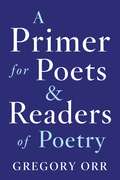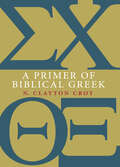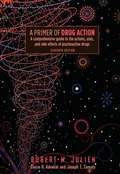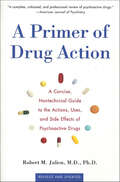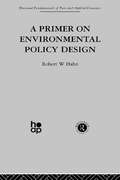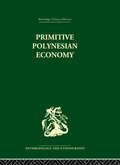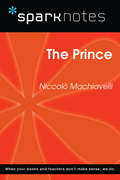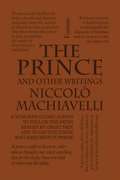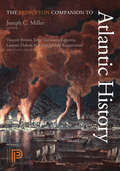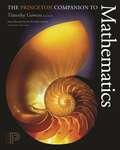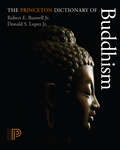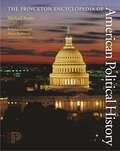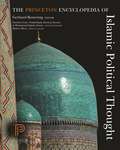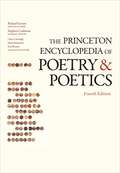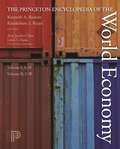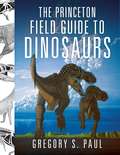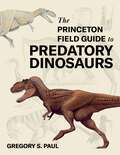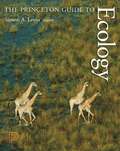- Table View
- List View
Primary Sources: Selected Writings on Color from Aristotle to Albers
by Patricia SloaneA selection of writings about color.
Primary Understanding: Education in Early Childhood (Routledge Library Editions: Education)
by Kieran EganBeginning with descriptions of the ways in which children make sense of their experience and the world, such as fantasy, stories and games, Egan constructs his argument that constituting this foundational layer are sets of cultural sense-making capacities, reflected in oral cultures throughout the world. Egan sees education as the acquisition of these sets of sense-making capacities, available in our culture, and his goal is to conceptualize primary education in a way that over comes the dichotomy between progressivisim and traditionalism, attending both the needs of the individual child and the accumulation of knowledge.
Primate Comparative Anatomy
by Daniel L. GeboA comprehensive, illustrated textbook that reveals the structural and functional anatomy of primates.Winner of the CHOICE Outstanding Academic Title of the Choice ACRLWhy do orangutan arms closely resemble human arms? What is the advantage to primates of having long limbs? Why do primates have forward-facing eyes? Answers to questions such as these are usually revealed by comparative studies of primate anatomy.In this heavily illustrated, up-to-date textbook, primate anatomist Daniel L. Gebo provides straightforward explanations of primate anatomy that move logically through the body plan and across species. Including only what is essential in relation to soft tissues, the book relies primarily on bony structures to explain the functions and diversity of anatomy among living primates. Ideal for college and graduate courses, Gebo's book will also appeal to researchers in the fields of mammalogy, primatology, anthropology, and paleontology.Included in this book are discussions of:• Phylogeny• Adaptation• Body size• The wet- and dry-nosed primates• Bone biology• Musculoskeletal mechanics• Strepsirhine and haplorhine heads• Primate teeth and diets• Necks, backs, and tails• The pelvis and reproduction• Locomotion• Forelimbs and hindlimbs• Hands and feet• Grasping toes
Prime Ministers of the 20th Century (Images of the The National Archives)
by Mark DuntonA concise history of each of the UK’s twentieth-century Prime Ministers, from Robert Gascoyne-Cecil to Tony Blair, featuring archival images and documents.This book gives an overview of each of the British Prime Ministers of the twentieth century, summarising their premierships, their policies, and the key events. It is lavishly illustrated with images of documents from The National Archives which give a fresh dimension to the study of the Prime Minister’s role, providing insights into their personalities and the pressures that Prime Ministers are subject to. Handwritten comments by Prime Ministers enable the reader to connect with the individual and how they felt at the time. There are dramatic episodes and examples of forthright reactions, but flashes of humour too.
Primer for Critiquing Social Research: A Student Guide
by Michael J. HoloskoCritique social research with ease with Primer for Critiquing Social Research: A Student Guide! In a simple, hands-on manner, this text helps you develop the analytical tools and critical thinking skills you need to successfully critique social research. Critiquing is made easy with a book-specific website which offers frequently asked questions, an evaluation template, and other information about the text and its use.
A Primer For ICD-10-CM Users: Psychological and Behavioral Conditions
by Carol D. GoodheartThis primer aims to give psychologists and other mental health professionals the information necessary to use the World Health Organization's 10th edition of the International Classification of Diseases and paves way for successful adoption of ICD-11.
A Primer for Poets and Readers of Poetry
by Gregory OrrAn innovative and accessible guide to poetry-writing by an award-winning poet and beloved professor of poetry. A Primer for Poets and Readers of Poetry guides the young poet toward a deeper understanding of how poetry can function in his or her life, while also introducing the art in an exciting new way. Using such poems as Theodore Roethke’s "My Papa’s Waltz" and Robert Hayden’s "Those Winter Sundays," the Primer encourages young writers to approach their "thresholds"—those places where disorder meets order, where shaping imagination can turn language into urgent and persuasive poems. It provides the poet with more than a dozen focused writing exercises and explains essential topics such as the personal and cultural threshold; the four forces that animate poetic language (naming, singing, saying, imagining); tactics of revision; ecstasy and engagement as motives for poetry; and how to locate and learn from our personal poetic forebears.
A Primer of Biblical Greek (Eerdmans Language Resources (ELR))
by N. Clayton CroyThough there are currently a number of texts for teaching biblical Greek, most of them are plagued by various deficiencies. Written with these flaws in mind, this new primer by N. Clayton Croy offers an effective, single-volume introduction to biblical Greek that has proven successful in classrooms around the country.This volume takes a primarily deductive approach to teaching biblical Greek and assumes that students have no prior knowledge of the language. Divided into 32 separate lessons, each containing a generous number of exercises, the text leads students from the Greek alphabet to a working understanding of the language of the Septuagint and the New Testament.Special features of A Primer of Biblical Greek:An abundance of exercisesEach lesson includes practice sentences taken from the Septuagint and the New Testament as well as Greek sentences composed by the author. Exercises in English-to-Greek translation are also included.Concise but accurate grammatical explanationsGreat care has been taken to insure that grammatical explanations are clear, correct, and succinct. In particular, the Greek participle receives a fuller-than-usual treatment.A natural order of presentationMaterial is presented according to the natural structure of Greek and the traditional terminology of grammarians. Declensions and principal parts, for example, are presented in numerical order.Inclusive languageThe book uses inclusive language for human beings throughout.Helpful appendixes for quick referenceIncluded at the back of the book are the Greek paradigms, Greek-to-English vocabulary, English-to-Greek vocabulary, and a bibliography for further study.
A Primer of Drug Action: A Comprehensive Guide to the Actions, Uses, and Side Effects of Psychoactive Drugs (11th edition)
by Robert M. JulienA definitive guide to the pharmacology of drugs that affect the mind and behavior with over 40% new research citations. A clearer and current presentation on the mechanisms of drug action, etiologies of major psychological disorders, rationales for drug treatment, and the uses of psychopharmacology in patient care.
A Primer of Drug Action: A Concise Nontechnical Guide to the Actions, Uses, and Side Effects of Psychoactive Drugs
by Robert M. JulienSince 1975, Robert Julien's A Primer of Drug Action has been the definitive guide to the effects of psychoactive drugs on the brain and on behavior. Now fully updated, this popular guide continues to lead the way through a rapidly changing field, providing readers with a clear, contemporary, and objective look at every drug and medication that either positively or adversely affects brain function. This edition includes important new information on:-Herbal medications-Drug therapy for behavioral and anxiety disorders-Clinical practice guidelines for treating psychological disorders-Depression and the action of antidepressant drugs-The use of newer anticonvulsants in the treatment of bipolar disorder, pain syndromes, and behavioral disorders-Drug therapy for children, adolescents and the elderly-"New generation" antipsychotic agentsAuthoritative, comprehensive, and suitable for those with little background in biology, A Primer of Drug Action is an indispensable source of information for anyone interested in drug use, abuse, and education.
A Primer on Environmental Policy Design
by R. HahnDiscusses how the needs of the individual must be balanced with socially desirable ecological goals if the environment is to be protected.
Primitive Polynesian Economy
by Raymond FirthA great classic of British anthropology, Primitive Polynesian Economy is structured as follows: · Problems of Primitive Economics · Food and Population in Tikopia · Knowledge, Technique and Economic Lore · The Labour Situation · Ritual in Productive Activity · Economic Functions of the Chiefs · Property and Capital in Production · Principles of Distribution and Payment · Exchange and Value · Characteristics of a Primitive Economy First published in 1939.
The Prince (SparkNotes Philosophy Guide)
by SparkNotesThe Prince (SparkNotes Philosophy Guide) Making the reading experience fun! SparkNotes Philosophy Guides are one-stop guides to the great works of philosophy–masterpieces that stand at the foundations of Western thought. Inside each Philosophy Guide you&’ll find insightful overviews of great philosophical works of the Western world.
The Prince and Other Writings (Wordsworth Classics)
by W. K. Marriott Niccolò MachiavelliOne of the foremost examples of modern philosophy, Niccolò Machiavelli's The Prince is notorious for the morality it expounds, often summarized by the phrase, "The end justifies the means." With The Prince, Machiavelli's intent was to provide practical advice for rulers and politicians, especially in regard to the unification of Italy. The Prince and Other Writings is an important book for those interested in history, politics, ethics, and human nature, and is now available as part of the Word Cloud Classics series, providing a chic and affordable addition to any library.
Princess with a Backpack
by Lauren ResnickA fun guide for the adventurous female traveler! With quotes, practical advice, and anecdotes from popular personalities, this travel guide helps princesses who want to leave their castles, see the world, and experience true adventure. Put on that backpack (even if it clashes with your cute outfit) and find out: How to plan your trip (without freaking out)What to wear for both comfort and styleHow to pack—for more than six months of travel timeHow to keep trim and still eat pizza in RomeEurope&’s best bars, parties, clothing stores, and accommodations—fit for a princess (all tried, tested and approved)—and more!
The Princeton Companion to Atlantic History
by Jorge Cañizares-Esguerra Vincent Brown Laurent Dubois Joseph C. Miller Karen Ordahl KuppermanBetween the fifteenth and nineteenth centuries, the connections among Africa, the Americas, and Europe transformed world history--through maritime exploration, commercial engagements, human migrations and settlements, political realignments and upheavals, cultural exchanges, and more. This book, the first encyclopedic reference work on Atlantic history, takes an integrated, multicontinental approach that emphasizes the dynamics of change and the perspectives and motivations of the peoples who made it happen. The entries--all specially commissioned for this volume from an international team of leading scholars--synthesize the latest scholarship on central themes, including economics, migration, politics, war, technologies and science, the physical environment, and culture.Part one features five major essays that trace the changes distinctive to each chronological phase of Atlantic history. Part two includes more than 125 entries on key topics, from the seemingly familiar viewed in unfamiliar and provocative ways (the Seven Years' War, trading companies) to less conventional subjects (family networks, canon law, utopias).This is an indispensable resource for students, researchers, and scholars in a range of fields, from early American, African, Latin American, and European history to the histories of economics, religion, and science.The first encyclopedic reference on Atlantic historyFeatures five major essays and more than 125 alphabetical entriesProvides essential context on major areas of change:Economies (for example, the slave trade, marine resources, commodities, specie, trading companies)Populations (emigrations, Native American removals, blended communities)Politics and law (the law of nations, royal liberties, paramount chiefdoms, independence struggles in Haiti, the Hispanic Americas, the United States, and France)Military actions (the African and Napoleonic wars, the Seven Years' War, wars of conquest)Technologies and science (cartography, nautical science, geography, healing practices)The physical environment (climate and weather, forest resources, agricultural production, food and diets, disease)Cultures and communities (captivity narratives, religions and religious practices)Includes original contributions from Sven Beckert, Holly Brewer, Peter A. Coclanis, Seymour Drescher, Eliga H. Gould, David S. Jones, Wim Klooster, Mark Peterson, Steven Pincus, Richard Price and Sophia Rosenfeld, and many moreContains illustrations, maps, and bibliographies
The Princeton Companion to Mathematics
by Timothy GowersThis is a one-of-a-kind reference for anyone with a serious interest in mathematics. Edited by Timothy Gowers, a recipient of the Fields Medal, it presents nearly two hundred entries, written especially for this book by some of the world's leading mathematicians, that introduce basic mathematical tools and vocabulary; trace the development of modern mathematics; explain essential terms and concepts; examine core ideas in major areas of mathematics; describe the achievements of scores of famous mathematicians; explore the impact of mathematics on other disciplines such as biology, finance, and music--and much, much more.Unparalleled in its depth of coverage, The Princeton Companion to Mathematics surveys the most active and exciting branches of pure mathematics. Accessible in style, this is an indispensable resource for undergraduate and graduate students in mathematics as well as for researchers and scholars seeking to understand areas outside their specialties.Features nearly 200 entries, organized thematically and written by an international team of distinguished contributorsPresents major ideas and branches of pure mathematics in a clear, accessible styleDefines and explains important mathematical concepts, methods, theorems, and open problemsIntroduces the language of mathematics and the goals of mathematical researchCovers number theory, algebra, analysis, geometry, logic, probability, and moreTraces the history and development of modern mathematicsProfiles more than ninety-five mathematicians who influenced those working todayExplores the influence of mathematics on other disciplinesIncludes bibliographies, cross-references, and a comprehensive indexContributors incude:Graham Allan, Noga Alon, George Andrews, Tom Archibald, Sir Michael Atiyah, David Aubin, Joan Bagaria, Keith Ball, June Barrow-Green, Alan Beardon, David D. Ben-Zvi, Vitaly Bergelson, Nicholas Bingham, Béla Bollobás, Henk Bos, Bodil Branner, Martin R. Bridson, John P. Burgess, Kevin Buzzard, Peter J. Cameron, Jean-Luc Chabert, Eugenia Cheng, Clifford C. Cocks, Alain Connes, Leo Corry, Wolfgang Coy, Tony Crilly, Serafina Cuomo, Mihalis Dafermos, Partha Dasgupta, Ingrid Daubechies, Joseph W. Dauben, John W. Dawson Jr., Francois de Gandt, Persi Diaconis, Jordan S. Ellenberg, Lawrence C. Evans, Florence Fasanelli, Anita Burdman Feferman, Solomon Feferman, Charles Fefferman, Della Fenster, José Ferreirós, David Fisher, Terry Gannon, A. Gardiner, Charles C. Gillispie, Oded Goldreich, Catherine Goldstein, Fernando Q. Gouvêa, Timothy Gowers, Andrew Granville, Ivor Grattan-Guinness, Jeremy Gray, Ben Green, Ian Grojnowski, Niccolò Guicciardini, Michael Harris, Ulf Hashagen, Nigel Higson, Andrew Hodges, F. E. A. Johnson, Mark Joshi, Kiran S. Kedlaya, Frank Kelly, Sergiu Klainerman, Jon Kleinberg, Israel Kleiner, Jacek Klinowski, Eberhard Knobloch, János Kollár, T. W. Körner, Michael Krivelevich, Peter D. Lax, Imre Leader, Jean-François Le Gall, W. B. R. Lickorish, Martin W. Liebeck, Jesper Lützen, Des MacHale, Alan L. Mackay, Shahn Majid, Lech Maligranda, David Marker, Jean Mawhin, Barry Mazur, Dusa McDuff, Colin McLarty, Bojan Mohar, Peter M. Neumann, Catherine Nolan, James Norris, Brian Osserman, Richard S. Palais, Marco Panza, Karen Hunger Parshall, Gabriel P. Paternain, Jeanne Peiffer, Carl Pomerance, Helmut Pulte, Bruce Reed, Michael C. Reed, Adrian Rice, Eleanor Robson, Igor Rodnianski, John Roe, Mark Ronan, Edward Sandifer, Tilman Sauer, Norbert Schappacher, Andrzej Schinzel, Erhard Scholz, Reinhard Siegmund-Schultze, Gordon Slade, David J. Spiegelhalter, Jacqueline Stedall, Arild Stubhaug, Madhu Sudan, Terence Tao, Jamie Tappenden, C. H. Taubes, Rüdiger Thiele, Burt Totaro, Lloyd N. Trefethen, Dirk van Dalen, Richard Weber, Dominic Welsh, Avi Wigderson, Herbert Wilf, David Wilkins, B. Yandell, Eric Zaslow, Doron Zeilberger
The Princeton Dictionary of Buddhism
by Robert E. Buswell Donald S. LopezThe most comprehensive and authoritative dictionary of Buddhism ever produced in EnglishWith more than 5,000 entries totaling over a million words, this is the most comprehensive and authoritative dictionary of Buddhism ever produced in English. It is also the first to cover terms from all of the canonical Buddhist languages and traditions: Sanskrit, Pali, Tibetan, Chinese, Japanese, and Korean. Unlike reference works that focus on a single Buddhist language or school, The Princeton Dictionary of Buddhism bridges the major Buddhist traditions to provide encyclopedic coverage of the most important terms, concepts, texts, authors, deities, schools, monasteries, and geographical sites from across the history of Buddhism. The main entries offer both a brief definition and a substantial short essay on the broader meaning and significance of the term covered. Extensive cross-references allow readers to find related terms and concepts. An appendix of Buddhist lists (for example, the four noble truths and the thirty-two marks of the Buddha), a timeline, six maps, and two diagrams are also included.Written and edited by two of today's most eminent scholars of Buddhism, and more than a decade in the making, this landmark work is an essential reference for every student, scholar, or practitioner of Buddhism and for anyone else interested in Asian religion, history, or philosophy.The most comprehensive dictionary of Buddhism ever produced in EnglishMore than 5,000 entries totaling over a million wordsThe first dictionary to cover terms from all of the canonical Buddhist languages and traditions—Sanskrit, Pali, Tibetan, Chinese, Japanese, and KoreanDetailed entries on the most important terms, concepts, texts, authors, deities, schools, monasteries, and geographical sites in the history of BuddhismCross-references and appendixes that allow readers to find related terms and look up equivalent terms in multiple Buddhist languagesIncludes a list of Buddhist lists, a timeline, and mapsAlso contains selected terms and names in Thai, Burmese, Vietnamese, Lao, Khmer, Sinhalese, Newar, and Mongolian
The Princeton Encyclopedia of American Political History. (Two volume set): Volume I and II
by Michael Kazin, Rebecca Edwards, Adam RothmanA comprehensive and authoritative encyclopedia of U.S. political historyAn essential resource for anyone interested in U.S. history and politics, this two-volume encyclopedia covers the major forces that have shaped American politics from the founding to today. Broad in scope, the book addresses both the traditional topics of political history—such as eras, institutions, political parties, presidents, and founding documents—and the wider subjects of current scholarship, including military, electoral, and economic events, as well as social movements, popular culture, religion, education, race, gender, and more.Each article, specially commissioned for this book, goes beyond basic facts to provide readers with crucial context, expert analysis, and informed perspectives on the evolution of American politics. Written by more than 170 leading historians and social scientists, The Princeton Encyclopedia of American Political History gives students, scholars, and researchers authoritative introductions to the subject's most important topics and a first step to further research.Features nearly 190 entries, organized alphabetically and written by a distinguished team of scholars, including Dean Baker, Lewis L. Gould, Alexander Keyssar, James T. Kloppenberg, Patricia Nelson Limerick, Lisa McGirr, Mark A. Noll, Jack N. Rakove, Nick Salvatore, Stephen Skowronek, Jeremi Suri, and Julian E. ZelizerDescribes key political periods and eras, from the founding to the present dayTraces the history of political institutions, parties, and founding documentsExplains ideas, philosophies, and movements that shaped American politicsPresents the political history and influence of geographic regionsDescribes the roles of ethnic, racial, and religious groups in the political processExplores the influence of mass culture, from political cartoons to the InternetExamines recurring issues that shape political campaigns and policy, from class, gender, and race to crime, education, taxation, voting, welfare, and much moreIncludes bibliographies, cross-references, appendixes, a comprehensive index, and more than 50 illustrations and maps
The Princeton Encyclopedia of Islamic Political Thought
by Richard Bulliet David Cook Roxanne L. Euben Khaled Fahmy Frank Griffel Bernard Haykel Robert W. Hefner Timur Kuran Jane McAuliffe Ebrahim MoosaAn indispensable guide to Islamic political thought from Muhammad to the twenty-first centuryThe first encyclopedia of Islamic political thought from the birth of Islam to today, this comprehensive, authoritative, and accessible reference provides the context needed for understanding contemporary politics in the Islamic world and beyond. With more than 400 alphabetically arranged entries written by an international team of specialists, the volume focuses on the origins and evolution of Islamic political ideas and related subjects, covering central terms, concepts, personalities, movements, places, and schools of thought across Islamic history. Fifteen major entries provide a synthetic treatment of key topics, such as Muhammad, jihad, authority, gender, culture, minorities, fundamentalism, and pluralism. Incorporating the latest scholarship, this is an indispensable resource for students, researchers, journalists, and anyone else seeking an informed perspective on the complex intersection of Islam and politics.Includes more than 400 concise, alphabetically arranged entriesFeatures 15 in-depth entries on key topicsCovers topics such as:Central themes and sources of Islamic political thought: caliph, modernity, knowledge, shari'a, government, revival and reformModern concepts, institutions, movements, and parties: civil society, Islamization, secularism, veil, Muslim BrotherhoodIslamic law and traditional Islamic societies: justice, taxation, fatwa, dissent, governance, piety and asceticism, trade and commerceSects, schools, regions, and dynasties: Mu'tazilis, Shi'ism, Quraysh, Mecca and Medina, Baghdad, Indonesia, Nigeria, Central Asia, OttomansThinkers, personalities, and statesmen: Mawardi, Shafi'I, Saladin, Tamerlane, Akbar, Atatürk, Nasser, KhomeiniContains seven historical and contemporary maps of Muslim empires, postcolonial nation-states, populations, and settlementsGuides readers to further research through bibliographies, cross-references, and an index
The Princeton Encyclopedia of Poetry and Poetics: Fourth Edition
by Roland GreeneThe most important poetry reference for more than four decades—now fully updated for the twenty-first century Through three editions over more than four decades, The Princeton Encyclopedia of Poetry and Poetics has built an unrivaled reputation as the most comprehensive and authoritative reference for students, scholars, and poets on all aspects of its subject: history, movements, genres, prosody, rhetorical devices, critical terms, and more. Now this landmark work has been thoroughly revised and updated for the twenty-first century. Compiled by an entirely new team of editors, the fourth edition—the first new edition in almost twenty years—reflects recent changes in literary and cultural studies, providing up-to-date coverage and giving greater attention to the international aspects of poetry, all while preserving the best of the previous volumes.At well over a million words and more than 1,000 entries, the Encyclopedia has unparalleled breadth and depth. Entries range in length from brief paragraphs to major essays of 15,000 words, offering a more thorough treatment—including expert synthesis and indispensable bibliographies—than conventional handbooks or dictionaries.This is a book that no reader or writer of poetry will want to be without.Thoroughly revised and updated by a new editorial team for twenty-first-century students, scholars, and poetsMore than 250 new entries cover recent terms, movements, and related topicsBroader international coverage includes articles on the poetries of more than 110 nations, regions, and languagesExpanded coverage of poetries of the non-Western and developing worldsUpdated bibliographies and cross-referencesNew, easier-to-use page designFully indexed for the first time
The Princeton Encyclopedia of the World Economy. (Two volume set)
by Kenneth A. Reinert Ramkishen S. RajanAn essential reference to all facets of the world economyIncreasing economic globalization has made understanding the world economy more important than ever. From trade agreements to offshore outsourcing to foreign aid, this two-volume encyclopedia explains the key elements of the world economy and provides a first step to further research for students and scholars in public policy, international studies, business, and the broader social sciences, as well as for economic policy professionals.Written by an international team of contributors, this comprehensive reference includes more than 300 up-to-date entries covering a wide range of topics in international trade, finance, production, and economic development. These topics include concepts and principles, models and theory, institutions and agreements, policies and instruments, analysis and tools, and sectors and special issues. Each entry includes cross-references and a list of sources for further reading and research. Complete with an index and a table of contents that groups entries by topic, The Princeton Encyclopedia of the World Economy is an essential resource for anyone who needs to better understand the global economy.More than 300 alphabetically arranged articles on topics in international trade, finance, production, and economic developmentInternational team of contributorsAnnotated list of further reading with each articleTopical list of entriesFull index and cross-references Entry categories and sample topics:Concepts and principles: globalization, anti-globalization, fair trade, foreign direct investment, international migration, economic development, multinational enterprisesModels and theory: Heckscher-Ohlin model, internalization theory, New Trade Theory, North-South trade, Triffin dilemmaInstitutions and agreements: European Union, International Monetary Fund, World Trade Organization, World Bank, Doha Round, international investment agreementsPolicies and instruments: dollar standard, international aid, sanctions, tariffsAnalysis and tools: exchange rate forecasting, effective protection, monetary policy rulesSectors and special issues: child labor, corporate governance, the digital divide, health and globalization, illegal drugs trade, petroleum, steel
The Princeton Field Guide to Dinosaurs
by Gregory S. PaulThis lavishly illustrated volume is the first authoritative dinosaur book in the style of a field guide. World-renowned dinosaur illustrator and researcher Gregory Paul provides comprehensive visual and textual coverage of the great Mesozoic animals that gave rise to the living dinosaurs, the birds. Incorporating the new discoveries and research that are radically transforming what we know about dinosaurs, this book is distinguished both by its scientific accuracy and the quality and quantity of its illustrations. It presents thorough descriptions of more than 735 dinosaur species and features more than 600 color and black-and-white images, including unique skeletal drawings, "life" studies, and scenic views--illustrations that depict the full range of dinosaurs, from small, feathered creatures to whale-sized supersauropods. Heavily illustrated species accounts of the major dinosaur groups are preceded by an extensive introduction that covers dinosaur history and biology, the extinction of nonavian dinosaurs, the origin of birds, and the history of dinosaur paleontology--and that also gives a taste of what it might be like to travel back to the time of the dinosaurs. The Princeton Field Guide to Dinosaursis a must-have for anyone who loves dinosaurs, from the amateur enthusiast to the professional paleontologist. The first authoritative field guide to dinosaurs Covers more than 735 species Beautiful, large-format volume Lavishly illustrated throughout, with more than 600 color and black-and-white drawings and figures, including: More than 130 color life studies, including scenic views Close to 450 skeletal, skull, head, and muscle drawings 8 color paleo-distribution maps Color timeline Describes anatomy, physiology, locomotion, reproduction, and growth of dinosaurs, as well as the origin of birds and the extinction of nonavian dinosaurs
The Princeton Field Guide to Predatory Dinosaurs (Princeton Field Guides)
by Gregory S. PaulAn authoritative illustrated guide to the fearsome predators that dominated the Mesozoic world for 180 million yearsNew discoveries are transforming our understanding of the theropod dinosaurs, revealing startling new insights into the lives and look of these awesome predators. The Princeton Field Guide to Predatory Dinosaurs provides the most up-to-date and comprehensive coverage of the mighty hunters that ruled the earth for tens of millions of years. This incredible guide covers some 300 species and features stunning illustrations of predatory theropods of all shapes and sizes. It discusses their history, anatomy, physiology, locomotion, reproduction, growth, and extinction, and even gives a taste of what it might be like to travel back to the Mesozoic. This one-of-a-kind guide also discusses the controversies surrounding these marvelous creatures, taking up such open questions as the form and habitats of the gigantic Spinosaurus and the number of Tyrannosaurus species that may have existed.Features detailed species accounts of some 300 theropod dinosaurs, with the latest size and mass estimatesShares new perspectives on iconic predators such as T. rex and VelociraptorCovers everything from the biology of predatory dinosaurs to the colorful history of paleontologyFeatures a wealth of color and black-and-white drawings and figures, including life studies, scenic views, and original skeletal, skull, and muscle reconstructionsIncludes detailed color maps
The Princeton Guide to Ecology
by Simon A. LevinThe Princeton Guide to Ecology is a concise, authoritative one-volume reference to the field's major subjects and key concepts. Edited by eminent ecologist Simon Levin, with contributions from an international team of leading ecologists, the book contains more than ninety clear, accurate, and up-to-date articles on the most important topics within seven major areas: autecology, population ecology, communities and ecosystems, landscapes and the biosphere, conservation biology, ecosystem services, and biosphere management. Complete with more than 200 illustrations (including sixteen pages in color), a glossary of key terms, a chronology of milestones in the field, suggestions for further reading on each topic, and an index, this is an essential volume for undergraduate and graduate students, research ecologists, scientists in related fields, policymakers, and anyone else with a serious interest in ecology. Explains key topics in one concise and authoritative volume Features more than ninety articles written by an international team of leading ecologists Contains more than 200 illustrations, including sixteen pages in color Includes glossary, chronology, suggestions for further reading, and index Covers autecology, population ecology, communities and ecosystems, landscapes and the biosphere, conservation biology, ecosystem services, and biosphere management

